胡壮麟语言学总复习ppt
- 格式:ppt
- 大小:1.06 MB
- 文档页数:164

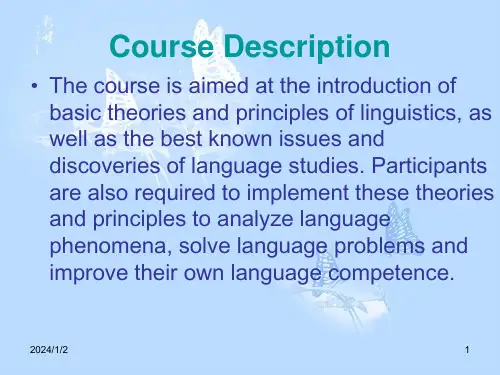
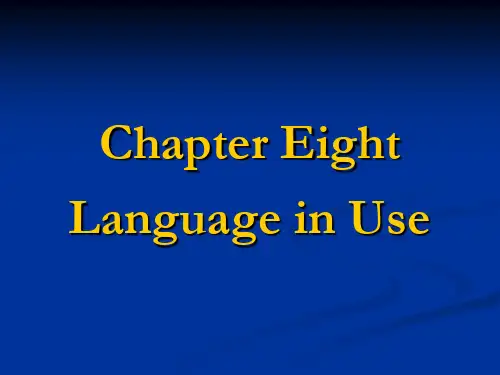
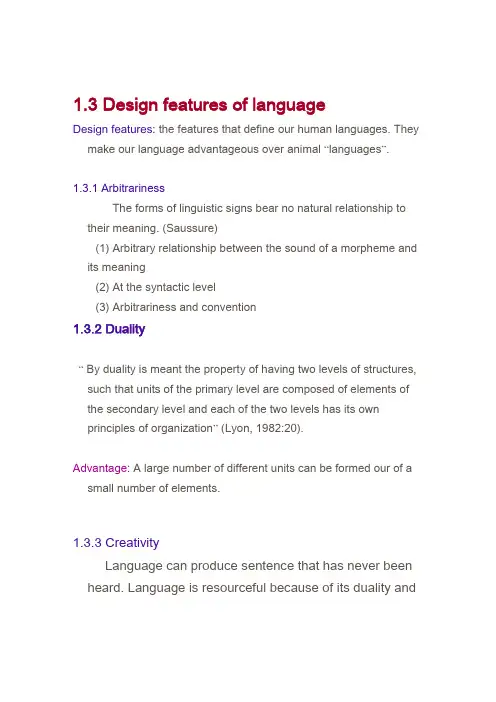
1.3 Design features of languageDesign features: the features that define our human languages. They make our language advantageous over animal “languages”.1.3.1 ArbitrarinessThe forms of linguistic signs bear no natural relationship to their meaning. (Saussure)(1) Arbitrary relationship between the sound of a morpheme andits meaning(2) At the syntactic level(3) Arbitrariness and convention1.3.2 Duality“ By duality is meant the property of having two levels of structures, such that units of the primary level are composed of elements of the secondary level and each of the two levels has its ownprinciples of organization” (Lyon, 1982:20).Advantage: A large number of different units can be formed our of a small number of elements.1.3.3 CreativityLanguage can produce sentence that has never been heard. Language is resourceful because of its duality andrecursiveness.1.3.4 DisplacementHuman languages enable their users to symbolize objects, events and concepts which are not present ( in time and space) at the moment of communication.Other design featuresCultural transmissionLanguage is passed down from generation to generation. Human being must be exposed to language environment.InterchangeabilityAny human being can be both a producer and receiver of the message.1.4 Origin of languageThe bow-wow theoryThe pooh-pooh theoryThe “yo-he-ho” theory1.5 Functions of language1.5.1 Informative1.5.2 Interpersonal function1.5.3 Performative1.5.4 Emotive function1.5.5 Phatic communion1.5.6 Recreational function1.5.7 Metalingual function1.6 What is linguistics?Linguistics is the scientific study of language.1.7 Main branches of linguistics1.7.1 PhoneticsPhonetics is the subfield of linguistics that studies speech sounds in human language.Major domains: Articulatory phonetics, Acoustic phonetics, Auditory phonetics1.7.2 Phonology-Phonology is the subfield of linguistics that studies the sound pattern of a language. -It deals with the rules governing the structure,distribution and sequencing of speech sounds and the shape of syllables.-Phonetics vs. PhonologyPhonetics is the study of speech sounds that the human voice is capable of creating whereas phonology is the study of a subset of those sounds that constitute language and meaning. The first focus on chaos while the second focuses on order.1.7.3 MorphologyMorphology is the subfield of linguistics that studies the internal structure of words and the relationships among words.1.7.4 SyntaxSyntax is the subfield of linguistics that studies the internal structure of sentences and the relationships among the internal parts.1.7.5 SemanticsSemantics is the subfield of linguistics that studies the nature of the meaning of individual words, and the meaning of wordsgrouped into phrases and sentences.1.7.6 PragmaticsPragmatics is the subfield of linguistics that studies the use of words, phrases and sentences in the actual context of discourse.1.8 Macrolinguistics1.8.1 PsycholinguisticsPsycholinguistics studies the relationship between language and mind. It also studies language development in the child, biological foundations of language and the relationship between language and cognition.1.8.2 SociolinguisticsSociolinguistics is the study of characteristics of language varieties, the characteristics of their functions, and thecharacteristics of their speakers.1.8.3 Anthropological linguisticsAnthropological linguistics is the study of the history and structure of formerly unwritten languages. They are concerned with the emergence and divergence of languages over thousands of years.1.8.4 Computational linguisticsComputational linguistics is an interdisciplinary field which centers around the use of computers to process or produce human language.1.9 Important distinctions in linguistics1.9.1 Descriptive vs. prescriptive-Descriptive (non-normative): to describe what people say. “… the linguist tries to discover and record the rules to which the members of a language-community actually conform and does not seek to impose upon them other rules, or norms, of correctness.” (Lyon, 1982:47)-Prescriptive: to prescribe how people should say. In the 18th century, the grammarians tried to lay down rules for the correct use oflanguage and settle the disputes over usage once and for all.1.9.2 Synchronic vs. diachronic-Synchronic linguistics is the study of a given language at a given period of time. E.g. “A Grammar of Modern Greek”-Diachronic linguistics is the study of the changes the language has experienced.1.9.3 Langue & parole (Saussure)-Langue is the abstract linguistic form or system shared by all the members of a speech community. It is a social product. It is a set of convention.-Parole is the actual or actualized language. It is the concrete use of the conventions or application of the rules.1.9.4 Competence and performance (Chomsky)-Competence refers to the ideal language speaker’s underlying knowledge about the system of rules.-Performance refers to the actual use of language by the speaker in concrete situation.1.9.5 Etic vs. Emic (Pike)Questions and ExercisesDo you think that onomatopoeia indicates a non-arbitrary relationship between form and meaning?Does the traffic light system have duality, why?Communication can take many forms, such as sign, speech, body language and facial expression. Do body language and facial expressionshare or lack the distinctive properties of human language?Can you mention some typical expressions of phatic communion in Chinese?。


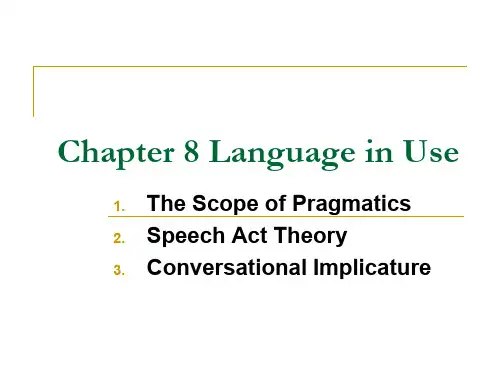

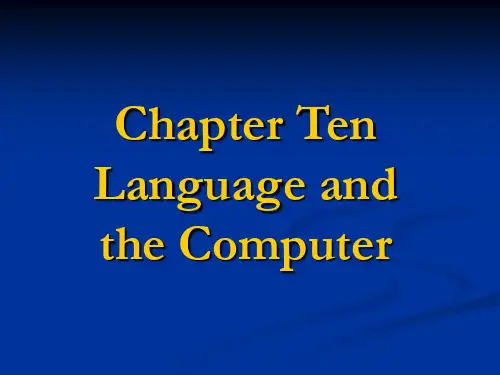

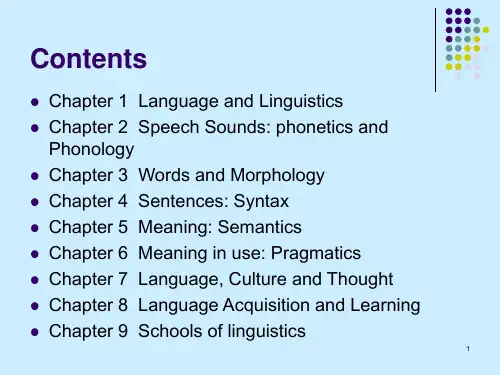
2. What is this course about?Chapter 1 Invitations to LinguisticsChapter 2 Speech SoundsChapter 3 LexiconChapter 4 SyntaxChapter 5 MeaningChapter 6 Language and cognitionChapter 7 Language, Culture, and SocietyChapter 8 Language in useChapter 9 language and literatureChapter 10 language and computerChapter 11 linguistics and foreign language teachingChapter 12 Theories and schools of modern linguistics1. languageDefinitionFeaturesFunctions1) Definition:Sapir, 1921: Language is a purely human and non-instinctive method of communicating ideas, emotions and desires by means of voluntarily produced symbols.(语言是纯粹人为的、非本能的、用任意制造出来的符号系统来传达观念、情绪和欲望的方法。
)Hall, 1968: Language is "the institution whereby humans communicate and interact with each other by means of habitually used oral-auditory arbitrary symbols." (语言是人们通过惯用的任意性的口头-听觉符号进行交际和互动的惯例。
语言学教程复习题与答案(胡壮麟版第一章)Chapter I IntroductionI. Decide whether each of the following statements is True or False:1. Linguistics is generally defined as the scientific study of language.2. Linguistics studies particular language, not languages in general.3. A scientific study of language is based on what the linguist thinks.4. In the study of linguistics, hypotheses formed should be based on languagefacts and checked against the observed facts.5. General linguistics is generally the study of language as a whole.6. General linguistics, which relates itself to the research of other areas, studiesthe basic concepts, theories, descriptions, models and methods applicable inany linguistic study. 7.7. Phonetics is different from phonology in that the latter studies thecombinations of the sounds to convey meaning in communication.8. Morphology studies how words can be formed to produce meaningfulsentences.9. The study of the ways in which morphemes can be combined to form words iscalled morphology.10. Syntax is different from morphology in that the former not only studies themorphemes, but also the combination of morphemes into words and words intosentences.11. The study of meaning in language is known as semantics.12. Both semantics and pragmatics study meanings.13. Pragmatics is different from semantics in that pragmatics studies meaning notin isolation, but in context.14. Social changes can often bring about language changes.15. Sociolinguistics is the study of language in relation to society.16. Modern linguistics is mostly prescriptive, but sometimes descriptive.17. Modern linguistics is different from traditional grammar.18. A diachronic study of language is the description of language at some point intime.19. Modern linguistics regards the written language as primary, not the writtenlanguage.20. The distinction between competence and performance was proposed by F.deSaussure.II. Fill in each of the following blanks with one word which begins with the lettergiven:21. Chomsky defines “competence”as the ideal user’s k__________ of the rulesof his language.ngue refers to the a__________ linguistic system shared by all the membersof a speech community while the parole is the concrete use of the conventions andapplication of the rules.23.D_________ is one of the design features of human language which refers to thepheno广告网址n that language consists of two levels: a lower level of meaninglessindividual sounds and a higher level of meaningful units.24. Language is a system of a_________ vocal symbols used for human communication.25. The discipline that studies the rules governing the formation of words into permissible sentences in languages is called s________.26. Human capacity for language has a g ____ basis, but the details of language have to be taught and learned.27. P ____ refers to the realization of langue in actual use.28. Findings in linguistic studies can often be applied to the settlement of some practical problems. The study of such applications is generally known as a________ linguistics.29. Language is p___________ in that it makes possible the construction and interpretation of new signals by its users. In other words, they can produce and understand an infinitely large number of sentences which they have never heard before.30. Linguistics is generally defined as the s ____ study of language.III. There are four choices following each statement. Mark the choice that can bestcomplete the statement.31. If a linguistic study describes and analyzes the language people actually use, itis said to be ______________.A. prescriptiveB. analyticC. descriptiveD. linguistic32.Which of the following is not a design feature of human language?A. ArbitrarinessB. DisplacementC. DualityD. Meaningfulness33. Modern linguistics regards the written language as ____________.A. primaryB. correctC. secondaryD. stable34. In modern linguistics, speech is regarded as more basic than writing, because___________. A. in linguistic evolution, speech is prior to writingB. speech plays a greater role than writing in terms of the amount of informationconveyed. C. speech is always the way in which every native speaker acquires hismother tongueD. All of the above35. A historical study of language is a ____ study of language.A. synchronicB. diachronicC. prescriptiveD. comparative36.Saussure took a (n)__________ view of language, while Chomsky looks at language from a ________ point of view.A. sociological…psychologicalB. psychological…sociologicalC. applied…pragmaticD.semantic and linguistic37. According to F. de Saussure, ____ refers to the abstract linguistic system shared by all the members of a speech community.A. paroleB. performanceC. langueD. Language38. Language is said to be arbitrary because there is no logical connection between_________ and meanings.A. senseB. soundsC. objectsD. ideas39. Language can be used to refer to contexts removed from the immediate situations of the speaker. This feature is called_________,A. displacementB. dualityC. flexibilityD. cultural transmission40. The details of any language system is passed on from one generation to the next through ____ , rather than by instinct.A. learningB. teachingC. booksD. both A and BIV. Define the following terms:41. Linguistics 42. Phonology 43. Syntax 44. Pragmatics 45. Psycholinguistics 46. Language 47. Phonetics 48. Morphology 49.Semantics 50. Sociolinguistics 51. Applied Linguistics 52.Arbitrariness 53 Productivity 54. Displacement 55.Duality 56. Design Features 57. Competence 58 Performance 59. Langue 60 ParoleV. Answer the following questions as comprehensively as possible. Give examples for illustration if necessary:61. Language is generally defined as a system of arbitrary vocal symbols used for human communication. Explain it in detail.62. What are the design features of human language? Illustrate them with examples.63. How is modern linguistics different from traditional grammar?64. How do you understand the distinction between a synchronic study and a diachronic study?65. Why does modern linguistics regard the spoken form of language as primary,not the written?66. What are the major distinctions between langue and parole?67. How do you understand competence and performance ?68. Saussure’s distinction between langue and parole seems similar to Chomsky’s distinction between competence and performance. What do you think are their major differences?69. Do you think human language is entirely arbitrary? Why?I. Decide whether each of the following statements is True or False:l.T 2.F 3.F 4.T 5.T 6.F 7.T 8.F 9.T 10.F 11.T 12.T 13.T 14.T 15. T 16.F 17.T 18.F 19.F 20.FII. Fill in each of the following blanks with one word which begins with the le tter given: 21. knowledge 22. abstract 23. Duality 24. arbitrary 25. syntax 26.genetic 27. Parole 28. applied 29. productive 30. scientific (or systematic)III. There are four choices following each statement. Mark the choice that can best complete the statement. 3l.C 32.D 33.C 34.D 35.B 36.A 37.C 38.B 39.A 40.DIV. Define the following terms: 41. Linguistics: Linguistics is generally definedas the scientific study of language. 42. Phonology: The study of how soundsare put together and used in communication is called phonology. 43. Syntax: The study of how morphemes and words are combined to form sentences is calledsyntax. 44.Pragmatics: The study of meaning in context of use is calledpragmatics. 45. Psycholinguistics: The study of language with reference tothe workings of mind is called psycholinguistics. 46. Language: Language is a system of arbitrary vocal symbols used for human communication.47. Phonetics: The study of sounds which are used in linguistic communication iscalled phonetics. 48. Morphology: The study of the way in which morphemesare arranged to form words is called morphology. 49. Semantics: Thestudy of meaning in language is called semantics. 50. Sociolinguistics:The study of language with reference to society is called sociolinguistics.51. Applied linguistics: In a narrow sense, applied linguistics refers to theapplication of linguistic principles and theories to language teaching and learning,especially the teaching of foreign and second languages. In a broad sense, it refersto the application of linguistic findings to the solution of practical problems such asthe recovery of speech ability. 52. Arbitrariness: It is one of the designfeatures of language. It means that there is no logical connection betweenmeanings and sounds 53. Productivity: Language is productive or creative inthat it makes possible the con-struction and interpretation of new signals by itsusers. 54. Displacement: Displacement means that language can be usedto refer to things which are present or not present, real or imagined matters in thepast, present, or future, or in far-away places. In other words, language can be usedto refer to contexts removed from the immediate situations of the speaker55. Duality: The duality nature of language means that language is a system, whichconsists of two sets of structure, or two levels, one of sounds and the other ofmeanings. 56. Design features: Design features refer to the definingproperties of human language that distinguish it from any animal system ofcommunication 57. Competence: Chomsky defines competence as the idealuser's knowledge of the rules of his language, 58. Performance: performance isthe actual realization of the knowl-edge of the rules in linguistic communication.59. langue : Langue refers to the abstract linguistic system shared by all the members of a speech community; Langue is the set of conventions and rule s which language users all have to follow; Langue is relatively stable, it does not change frequently 60. Parole: Parole refers to the realization of lang ue in actual use; parole is the concrete use of the conventions and the appli cation of the rules; parole varies from person to person, and from situation t o situation.V. Answer the following questions as comprehensively as possible. Give exam ples for illustration if necessary:61. Language is generally defined as a system of arbitrary vocal symbols used for human communication. Explain it in detail.First of all, language is a sys tem, because elements of language are combined according to rules. Secondl y, language is arbitrary because there is no intrinsic connection between form and meaning, or between the sign and what it stands for. Different language s have different words for the same object in the world. This fact is a good i llustration of the arbitrary nature of language. This also explains the symbolic nature of language: words are just symbols; they are associated with object s, actions, ideas, etc. by convention . Thirdly, language is vocal because the primary medium is sound for all languages, no matter how well - developed t heir writing systems are. The term "human" in the definition indicates that l anguage is possessed by human beings only and is very different from the c ommunication systems of other living creatures. The term "communication" m eans that language makes it possible for its users to talk to each other and fulfill their communicative needs.62. What are the design features of human language? Illustrate them with ex amples. 1) Arbitrariness As mentioned earlier, the arbitrary property of langu age means that there is no logical connection between meanings and sounds. For instance, there is no necessary relationship between the word elephant and the animal it symbolizes. In addition, different sounds are used to refer t o the same object in different languages, and even within the same language, the same sound does not refer to the same thing. However, language is not entirelyarbitrary. There are words which are created in the imitation of sound s by sounds, such as crash, bang in English. Besides, some compound word s are also not entirely arbitrary. But the non-arbitrary words are quite limited in number. The arbitrary nature of language makes it possible for language to have an unlimited source of expressions. 2) Productivity Language is prod uctive or creative in that it makes possible the construction and interpretationof new signals by its users. This is why they can produce and understand a n infinitely large number of sentences, including sentences that they have ne ver said or heard before. They can send messages which no one else has ev er sent before. Productivity is unique to human language. Most animal comm unication systems appear to be highly restricted with respect to the number of different signals that their users can send and receive. 3) Duality The du ality nature of language means that language is a system, which consists of two sets of structure, or two levels, one of sounds and the other of meaning s. At the lower or the basic level, there is the structure of sounds, which are meaningless, discrete, individual sounds. But the sounds of language can be combined according to rules into units of meaning such as morphemes and words, which, at the higher level, can be arranged into sentences. This duality of structure or double articulation of language enables its users to talk abou t anything within their knowledge. No animal communication system has duali ty or even comes near to possessing it. 4) Displacement Displacement mea ns that language can be used to refer to things which are present or not present, real or imagined matters in the past, present, or future, or in far-away p laces. In other words, language can be used to refer to contexts removed fro m the immediate situations of the speaker. Animal calls are mainly uttered in response to immediate changes of situation. 5) Cultural transmission Huma n beings were born with the ability to acquire language, but the details of an y language are not genetically transmitted or passed down by instinct. They have to be taught and learned, but animal call systems are genetically transmi tted.63. How is modern linguistics different from traditional grammar? Traditional gram-mar is prescriptive; it is based on "high "(religious, literary) writte n language. It sets grammatical rules and imposes the rules on language users. But Modern linguistics is descriptive; It collects authentic, and mai nly spoken language data and then it studies and describes the data in a n objective and scientific way.64. How do you understand the distinction between a synchronic study anda diachronic study? The description of a language at some point in timeis a Synchronic study; the description of a language as it changes throu gh time is a diachronic study. A synchronic study of language describesa language as it is at some particular point in time, while a diachronic study of language is the study of the historical development of language o ver a period of time.65. Why does modern linguistics regard the spoken form of language as primary, not the written? First, the spoken form is prior to the writ-ten for m and most writing systems are derived from the spoken form of langua ge. Second, the spoken form plays a greater role than writing in terms of the amount of information conveyed and it serves a wider range of purp oses Finally, the spoken form is the medium through which we acquire o ur mother tongue.66. What are the major distinctions between langue and parole? The distinction between langue, and parole was made by the famous linguist Ferdinand de Saussure early this century. Langue refers to the abstract linguisticsystem shared by all the members of a speech community, and parole ref ers to the realization of langue in actual use. Langue is the set of conve ntions and rules which language users all have to follow while parole is t he concrete use of the conventions and the application of the rules. Lang ue is abstract; it is not the language people actually use, but parole is c oncrete; it refers to the naturally occurring language events. Langue is rel atively stable; it does not change frequently; while parole varies from per son to person, and from situation to situation.67. How do you understand competence and performance? American linguist N. Chomsky in the late 1950’s proposed the distinction between comp etence and performance. Chomsky defines competence as the ideal user’s knowledge of the rules of his language. This internalized set of rules e nables the language user to produce and understand an infinitely large n umber of sentences and recognize sentences that are ungrammatical and ambiguous. According to Chomsky, performance is the actual realization of this knowledge in linguistic communication. Although the speaker’s knowledge of his mother tongue is perfect, his performances may have mista kes because of social and psychological factors such as stress, embarras sment, etc.. Chomsky believes that what linguists should study is the co mpetence, which is systematic, not the performance, which is too haphaz ard.68. Saussure’s distinction between langue and parole seems similar to Chomsky’s distinction between competence and performance. What do you thi nk are their major differences? Although Saussure’s distinction and Cho msky’s are very similar, they differ at least in that Saussure took a soci ological view of language and his notion of langue is a mater of social c onventions, and Chomsky looks at language from a psychological point of vies and to him, competence is a property of the mind of each individual.69. Do you think human language is entirely arbitrary? Why? Language isarbitrary in nature, it is not entirely arbitrary, because there are a limited number of words whose connections between forms and meanings can be logically explained to a certain extent, for example, the onomatopoeia,words which are coined on the basis of imitation of sounds by sounds s uch as bang, crash,etc.. Take compounds for another example. The two el ements “photo”and “copy”in “photocopy”are non-motivated, but t he compound is not arbitrary.语言学教程复习题与答案(胡壮麟版第二章)Chapter 2:PhonologyI. Decide whether each of the following statements is True or False:1. Voicing is a phonological feature that distinguishes meaning in both Chinese and English.2. If two phonetically similar sounds occur in the same environments and they distinguish meaning, they are said to be in complementary distribution.3. A phone is a phonetic unit that distinguishes meaning.4. English is a tone language while Chinese is not.5. In linguistic evolution, speech is prior to writing.6. In everyday communication, speech plays a greater role than writing in terms of the amount of information conveyed.7. Articulatory phonetics tries to describe the physical properties of thestream of sounds which a speaker issues with the help of a machinecalled spectrograph.8. The articulatory apparatus of a human being are contained in three important areas: the throat, the mouth and the chest.9. Vibration of the vocal cords results in a quality of speech sounds called voicing.10. English consonants can be classified in terms of place of articulationand the part of the tongue that is raised the highest.11. According to the manner of articulation, some of the types into whichthe consonants can be classified are stops, fricatives, bilabial and alv eolar.12. Vowel sounds can be differentiated by a number of factors: the position of tongue in the mouth, the openness of the mouth, the shape of the lips, and the length of the vowels.13. According to the shape of the lips, vowels can be classified into close vowels, semi-close vowels, semi-open vowels and open vowels.14. Any sound produced by a human being is a phoneme.15. Phones are the sounds that can distinguish meaning.16. Phonology is concerned with how the sounds can be classified into different categories.17. A basic way to determine the phonemes of a language is to see if substituting one sound for another results in a change of meaning.18. When two different forms are identical in every way except for one sound segment which occurs in the same place in the strings, the two words are said to form a phonemic contrast.19. The rules governing the phonological patterning are language specific.20. Distinctive features of sound segments can be found running over asequence of two or more phonemic segments.II. Fill in each of the following blanks with one word which begins with t he letter given:21. A ____ refers to a strong puff of air stream in the production of speech sounds.22. A ____ phonetics describes the way our speech organs work to produce the speech sounds and how they differ.23. The four sounds /p/,/b/,/m/ and /w/ have one feature in common, i.e, they are all b_______ sounds.24. Of all the speech organs, the t ____ is the most flexible, and is responsible for varieties of articulation than any other.25. English consonants can be classified in terms of manner of articulation or in terms of p____ of articulation.26. When the obstruction created by the speech organs is total or complete, the speech sound produced with the obstruction audibly released a nd the air passing out again is called a s________. <![endif]>27. S_________ features are the phonemic features that occur above the level of the segments. They include stress, tone, intonation, etc.28. The rules that govern the combination of sounds in a particular language are called s ____ rules.29. The transcription of speech sounds with letter-symbols only is calledbroad transcription while the transcription with letter-symbols together with the diacritics is called n_________ transcription.30. When pitch, stress and sound length are tied to the sentence rather than the word in isolation, they are collectively known as i_________.31. P______ is a discipline which studies the system of sounds of a particular language and how sounds are combined into meaningful units t o effect linguistic communication.32. The articulatory apparatus of a human being are contained in three important cavities: the pharyngeal cavity, the o_______ cavity and the na sal cavity.33. T____ are pitch variations, which are caused by the differing rates ofvibration of the vocal cords and which can distinguish meaning just li ke phonemes. <![endif]>34. Depending on the context in which stress is considered, there are twokinds of stress: word stress and s_________ stressIII. There are four choices following each of the statements below. Mark t he choice that can best complete the statement.35. Of all the speech organs, the _______ is/ are the most flexible. A. mouth B. lips C. tongue D. vocal cords36. The sounds produced without the vocal cords vibrating are ____ sounds. A. voiceless B. voiced C. vowel D. consonantal37. __________ is a voiced alveolar stop.A. /z/B. /d/C. /k/D./b/38. The assimilation rule assimilates one sound to another by “copying”a feature of a sequential phoneme, thus making the two phones ____________. A. identical B. same C. exactly alike D. similar39. Since /p/ and /b/ are phonetically similar, occur in the same environments and they can distinguish meaning, they are said to be _________ __.A. in phonemic contrastB. in complementary distributionC. the allophonesD. minimal pair40. The sound /f/ is _________________. A. voiced palatal affricateB. voiced alveolar stopC. voiceless velar fricativeD. voiceless labiodental fricative41. A ____ vowel is one that is produced with the front part of the tongue maintaining the highest position. A. back B. central C. front D. middle42. Distinctive features can be found running over a sequence of two ormore phonemic segments. The phonemic features that occur above the level of the segments are called ____________. A. phonetic components B. immediate constituents C. suprasegmental features D. se mantic features43. A(n) ___________ is a unit that is of distinctive value. It is an abstractunit, a collection of distinctive phonetic features. A. phone B. so und C. allophone D. phoneme44. The different phones which can represent a phoneme in different phonetic environments are called the ____ of that phoneme. A. phones B. sounds C. phonemes D. allophones <![endif]>IV. Define the terms below:45. phonology 46. phoneme 47.allophone 48. international phonetic alphabet 49. intonation 50. phonetics 51. auditory phonetics52. acoustic phonetics 53. phone 54. phonemic contrast 55. tone 56. minimal pairV. Answer the following questions as comprehensively as possible. Give ex-amples for illustration if necessary:57. Of the two media of language, why do you think speech is more basic than writing?58. What are the criteria that a linguist uses in classifying vowels?59. What are the major differences between phonology and phonetics?60. Illustrate with examples how suprasegmental features can affect meaning.61. In what way can we determine whether a phone is a phoneme or not?I. Decide whether each of the following statements is True or False:l.T 2.F 3.F 4.F 5.T 6.T 7.F 8.F 9.T 10.F 11.F 12.T 13.F 14.F 15.F 16. F 17. T 18. F 19. T 20. TII. Fill in each of the following blanks with one word which begin s with the letter given:21. Aspiration 22.Articulatory 23. bilabial 24. tongue 25. place 26. stop 27. Suprasegmental 28. sequential 29. narrow 30. intonation 31. P honology 32. oral 33. Tone 34. sentenceIII. There are four choices following each of the statements below.Mark the choice that can best complete the statement:35.C 36.A 37.B 38.D 39.A 40.D 41.C 42.C 43.D 44.DIV. Define the terms below:45.phonology: Phonology studies the system of sounds of a particular lan guage; it aims to discover how speech sounds in a language form patter ns and how these sounds are used to convey meaning in linguistic com munication.46. phoneme: The basic unit in phonology is called phoneme; it is a unitof distinctive value. But it is an abstract unit. To be exact, a phoneme is not a sound; it is a collection of distinctive phonetic features.47. allophone: The different phones which can represent a phoneme in different phonetic environments are called the allophones of that phoneme.48. international phonetic alphabet: It is a standardized and internationallyaccepted system of phonetic transcription.49. intonation: When pitch, stress and sound length are tied to the sentence rather than the word in isolation, they are collectively known as i ntonation.50.51. phonetics: Phonetics is defined as the study of the phonic medium of language; it is concerned with all the sounds that occur in the world' s languages52. auditory phonetics: It studies the speech sounds from the hearer's point of view. It studies how the sounds are perceived by the hear-er. 53. acoustic phonetics: It studies the speech sounds by looking at the sound waves. It studies the physical means by which speech sounds a re transmitted through the air from one person to another.54. phone : Phones can be simply defined as the speech sounds we usewhen speaking a language. A phone is a phonetic unit or segment. It does not necessarily distinguish meaning.55. phonemic contrast: Phonemic contrast refers to the relation between two phonemes. If two phonemes can occur in the same environment a nd distinguish meaning, they are in phonemic contrast.56. tone: Tones are pitch variations, which are caused by the differing rates of vibration of the vocal cords.57. minimal pair: When two different forms are identical in every way except for one sound segment which occurs in the same place in the stri ngs, the two words are said to form a minimal pair.V. Answer the following questions as comprehensively as possible. Give ex-amples for illustration if necessary:58. Of the two media of language, why do you think speech is more basic than writing? 1) In linguistic evolution, speech is prior to writing.2) In everyday communication, speech plays a greater role than writing in terms of the amount of information conveyed. 3) Speech is always the way in which every native speaker acquires his mother tongue, and writing is learned and taught later at school.59. What are the criteria that a linguist uses in classifying vowels?。
胡壮麟语言学课件chapter12(名牌大学教授整理)胡壮麟语言学课件chapter11-名牌大学教授整理胡壮麟语言学chapter10(名牌大学教授整理)胡壮麟语言学第九章课件-名牌大学教授整理胡壮麟语言学第八章课件(名牌大学教授整理)胡壮麟语言学第六章课件(名牌大学教授整理)胡壮麟语言学第五章课件(名牌大学教授整理)胡壮麟语言学第四章课件(名牌大学教授整理)胡壮麟语言学第三章课件(名牌大学教授整理)胡壮麟英语语言学教学笔记Chapter 2 (名牌大学语言学教授整理)胡壮麟语言学教程第一章课件,名牌大学英语专业课课件,概括很全面,很到位哦胡壮麟语言学分章练习课件-chapter 12(名牌大学教授整理)胡壮麟语言学分章练习课件-chapter 8(名牌大学教授整理)胡壮麟语言学分章练习课件-chapter 7(名牌大学教授整理)胡壮麟语言学分章练习课件-chapter 6(名牌大学教授整理)胡壮麟语言学分章练习课件-chapter 5(名牌大学教授整理)胡壮麟语言学分章练习课件-chapter 4(名牌大学教授整理)胡壮麟语言学分章练习课件-chapter 2(名牌大学教授整理)胡壮麟语言学分章练习课件-chapter 1(名牌大学教授整理)大家论坛--英语专业考研--资料汇总--希望能对您的英语学习有帮助!!!鲜花送人,留己余香。
如果您觉得资料好,请您转发给需要的人——英语专业考研者没时间找资料的同学和朋友。
英语专业在校大学生希望获得本专业信息的人。
谢谢您!如有打扰,请包涵!更多考试经验的帖子在:大家论坛-英语专业考研版/forum-406-1.htmlQQ群大家论坛英语专业考研:221970617 ,欢迎您的加入。
高级英语第二册教材及教师用书第一册rar下载孙亦丽--大学英语精读学习精要--第一册第二册第三册pdf 下载孙辉的简明法语教程练习参考答案rar《480个最有用的法语动词》09年出版pdf下载大家论坛大学俄语阅读高分突破与技巧pdf 2005年版大家网《俄语语义:句法集成描写模式》下载【大家论坛】大学德语4(修订版)pdf--2003年版高教出版社张书良【大家论坛】传播学原理2009年版张国良《英语语言学基础》学习指南-南温洪瑞主编1999年08月版pdf基础英语真题:(北外)00-09年基础英语试题及答案详解大家论坛-英语专业考研版-真题+资料汇总/forum-406-1.html(华东师大)06年华东师大基础英语(华东师大)基础英语08-09年真题(华东师大)2007年“基础英语” 和“翻译”(华东师大)2008年“基础英语”和“翻译”(华东师大)03年基础英语(四川外语学院)09年基础英语真题(西外) 04年基础英语真题(川外) 05年基础英语真题(广外)历年基础英语考试真题(考研真题)天外07年基础英语节选(对外经贸大学)基础英语02-07年真题(对外经贸大学)09、10年基础英语考研真题(对外经贸大学)2001基础英语考研试题.pdf(南京师大)基础英语2004(南京师大)基础英语2003(南京师大)基础英语2001(大连海事大学)基础英语08-09年真题(山东师范大学)基础英语06-09年真题(外交学院)02-04年基础英语真题(华中师大) 07年基础英语真题(考研真题) 08 年中大基础英语(考研真题)09年中大基础英语(武大)2007基础英语(武大)2006基础英语法语真题:(北外)1998-2009年法语二外真题(北外)2002~2009北外法语二外真题答案)(北外)08年二外法语(北师)04年法语二外考研真题(上外)07年二外法语试题(上外)二外法语05-07年真题及答案(上外) 09 二外法语考研真题(对外经贸)09年二外法语试题(华东师大)08-09年法语二外真题(华东师大)2007年二外法语(华东师大)03-04年二外法语大家论坛-英语专业考研版-真题+资料汇总/forum-406-1.html(人民大学)02-07年法语二外真题(武汉大学)02-04年二外法语真题(大连外国语学院)2003年二外法语试题日语真题:(上海外国语大学)二外日语历年真题(北外)二外日语真题及丰富的资料!(中南大学)2006-2007年日语二外真题(南京师大)日语二外 2004(南京师大)日语二外 2001德语真题:(广外)二外德语真题(厦大)英专考研德语(二外)真题参考答案(厦大)英语专业考研德语(二外)真题北外西班牙真题:(北外)2001到2007 年西班牙语考试真题(山东师范大学)06-09年二外法语+二外日语(武汉大学)08年二外日语+法语真题(对外经贸)商英+笔译+口译+二外俄语翻译真题:(广外)英语专业历年初试真题水平+翻译与写作(武汉大学)2009综合英语汉译英真题及参考答案(南京大学)2007基础英语汉译英及参考答案文本及pdf (广外)10年写作与翻译真题(上外)01-08年英汉互译真题(外交学院)翻译真题及答案语言学方面真题:(中南大学)2006年英语语言文学与文化综合知识真题(四川外语学院)01-06年英语语言文学真题(长安大学)2007年英语语言学真题(四川外国语大学)英语专业2006年考研真题英美文学真题:(上海交通大学)07年英美文学考研真题(深圳大学)05年英美文学真题================================================= 语言学资料:英语修辞手法经济学人文本大家论坛-英语专业考研版-真题+资料汇总/forum-406-1.html英语语言学资料《英语语言学基础》学习指南-南温洪瑞主编1999年08月版pdf (华中师范大学)语言学课本教程2010版戴伟栋语言学笔记liguistics--胡壮麟超赞的笔记英美文学资料:高教版《英美文学选读》课文译文《英国文学简史》中文版英国文学主要作家作品汇总《英美文学史》之英国文学作家作品大全《美国文学简史》(上)中文版英国文学史考试要点英美文学部分作家的介绍和评论外国文学史图表版笔记整理英国文学部分作品分析英美文学超全题库十套考研英美概况练习题(含答案)翻译资料:汉语成语典故谚语与歇后语英语翻译全国68所院校英汉互译试题分析英语专业考研翻译超全面的笔记~英语专业考研各大院校题型对比分析pdf法语真题回忆版:(北师)2010年二外法语真题回忆版(广外)10年二外法语试题回忆(北京师范大学)2010年二外法语真题回忆版(南京师大) 09外院二外法语回忆大学法语简明教程笔记汇总记忆法语名词阴阳性的方法法语重要句型汇总实用法语语法 - 精讲与练习(中国宇航出版社)日语学习资料:日本语表现文型辞典(最全最实用的句型大全)日语语法及词汇练习题1500题标准日本语法笔记资料考研日语(非日语专业)资料大家论坛-英语专业考研版-真题+资料汇总/forum-406-1.html日语二外考研作文18篇93年到07年的全国日语考试日语二外需掌握的最基本词汇大家论坛-英语专业考研版-真题+资料汇总/forum-406-1.html。